The whole plot is given away by the two-word title, & there will be no wavering from the obvious. The Wasp Woman (1960) comes off more as a cheap variant of The Wolf Man (1941) rather than The Fly (1958). With a properly low expectation, it won't be a disappointment.
As the film opens we observe rustic beekeepers at work, one of them collecting a paperwasp nest from the woods. He regards wasps with even more delight than the bees, to his bee-handling friend's amusement & his employer's annoyance. It's a pastoral sequence devoid of menace yet which manages to infuse the endeavors with interest.
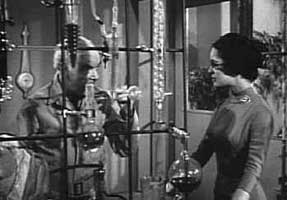 Meanwhile in the city, Janice Starlin (Susan Cabot in her last film role) is at her board-meeting for Janice Starlin Enterprises, a cosmetics company she has built up for sixteen years. Sales are slipping because Janice herself has always been the company's symbol of youthful beauty, & she's no longer young. Also she wears ugly glasses & scrunches up her face so that we might not notice she's pretty good looking even before she gets the youth formula. Meanwhile in the city, Janice Starlin (Susan Cabot in her last film role) is at her board-meeting for Janice Starlin Enterprises, a cosmetics company she has built up for sixteen years. Sales are slipping because Janice herself has always been the company's symbol of youthful beauty, & she's no longer young. Also she wears ugly glasses & scrunches up her face so that we might not notice she's pretty good looking even before she gets the youth formula.
One day the eccentric beekeeper who prefers wasps, Eric Zinthrop (Michael Mark), introduces himself to Janice as an independent scientist. We can surmise he was fired from his previous post for neglecting the honeybees in favor of carnivorous wasps. Zinthrop asks only that he be permitted to show Miss Starlin a quick experiment with his extracts of a queen wasp's royal jelly, & then she can decide whether or not to give him the laboratory & funding he requires.
Injecting an elderly guinea pig with the enzyme, it immediately turns into a pet rat, which we're apparently supposed to mistake for a younger guinea pig. Miss Starlin is wildly impressed & immediately hires the old man & gives him everything he requests to finish his rejuvenation experiments.
Starlin demands that she be the next guinea pig, despite Zinthrop's doubts that the process is ready for human use. Apart from feminine vanity, she needs again to be the youthful symbol of her cosmetics company.
When the formula does not work instantly as it did on the rodents, she begins to sneak into the lab after hours to inject herself with larger doses.
Compared to other no-budget horror thrillers, Roger Corman's brand frequently delivers an entertaining package. The b/w cinematography has a noirish appeal, & Fred Katz's jazzy score (heard also that same year in Little Shop of Horrors) is actually pretty good music.
For something like fifty-one minutes, this story is dragged out with very little happening, yet it manages to be successfully involving. Susan Cabot was a good actress & the wonderful character actor playing Zinthrop never wavers in his role's conviction. Even the bland supporting cast is no embarrassment. Corman could recognize a good actor on the way up or on the way down & only rarely settled for actors who simply couldn't do the job, & this was alone sufficient to put his films ahead of his contemporary shlockers.
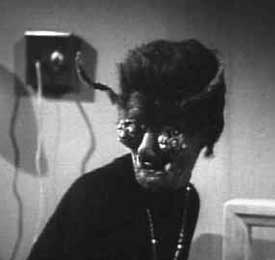 As various officers of the company & Miss Starlin's own secretary (Barboura Morris) conspire to find out what Zinefield's secret research is about, a good degree of suspense is maintained, even though always at a low level of expectation. As various officers of the company & Miss Starlin's own secretary (Barboura Morris) conspire to find out what Zinefield's secret research is about, a good degree of suspense is maintained, even though always at a low level of expectation.
The first transformation of the company's founder occurs fifty-two minutes into the film, & it's hard not to giggle. The film's padding has been more interesting than this monster, which consists of goofy bug-eyes that seem likely to fall off if jiggled too much, plus blackface, & an ugly wig with antennae.
Oh, & there are the claw-gloves likely left over from some other cheapie. The monstrous Wasp Woman is otherwise an actress with nice gams & a neatly pressed dress, hardly the epitome of terror bound to join Frankenstein, the Mummy, & Creature of the Black Lagoon as great creatures of horror.
Wasp Woman kills one of her nosy board members, sucks his blood, & turns back into Janice. There'll be a couple more victims during the last half hour & a plot complication of Zinthrop getting run over by a car & unable to continue his researches.
Starlin in a panic keeps injecting the wasp enzyme which has made her look youthful (as has discarding the ugly glasses she formerly wore). She keeps killing for blood each time she becomes the wasp woman. When the film has reached a length that will suffice for a feature, she's summarily killed & chucked out the window.
The original posters & newspaper ads for this film showed a woman-headed wasp killing guys, so it must've been quite a letdown to see a monster no more interesting than what some kids might trump up for halloween. But in those days everyone got double features plus a cartoon so it was forgiven.
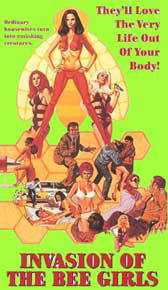 A man is found dead in a white trash motel room, dead of a heart attack which apparently occurred during sex, in the pre-credits scene for Invasion of the Bee Girls (1973). A man is found dead in a white trash motel room, dead of a heart attack which apparently occurred during sex, in the pre-credits scene for Invasion of the Bee Girls (1973).
The guy's death doesn't raise too many alerts until later that same day a second body is found, of a young man who seems likewise to have had a heart attack while otherwise getting lucky.
A military agent shows up to investigate, Neil Agar by name (William Smith), which surprises sheriff Jim Peters (Cliff Osmond). It turns out the first victim was a scientist researching bacterial warfare.
Despite that deaths can be ascribed to natural causes, when they begin to mount up under the same conditions, there can be no question but that foul play is somehow involved.
Apparently beautiful women are killing unattractive guys merely by having sex with them, & it's somehow related to the nearby military research center.
Whoever these killer babes are, some of them don't like to take no for an answer, as a gay researcher from the lab, who didn't respond to one of the women's attempts at seduction, got angrily run down by a car. Agent Agar has a fairly respectful interview with the dead man's lover, though in 1973 was still not common to treat gays in the cinema as otherwise normal couples.
Dark-haired Dr. Susan Harris (Anitra Ford), scientist babe, always wears dark sunglasses even indoors, at all times of day & night. No one seems to notice though I'd think they'd at least wonder if she was an addict, even if they didn't suspect she has insect eyes.
After forty minutes of screen time Susan finally takes off her glasses. What a disappointment she has normal eyes. The insect-ness of her eyes comes & goes, depending on whether she's aroused. The next time we see her eyes they'll be weird & black.
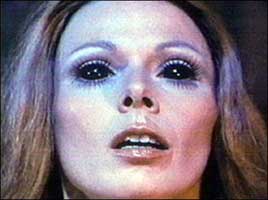 Some experiment in Susan's lab went wonderfully wrong. She's become the queen bee-woman transforming other women from around the area into bee-women too, in a secret lab with cool blinky light computers & techno-hive. Some experiment in Susan's lab went wonderfully wrong. She's become the queen bee-woman transforming other women from around the area into bee-women too, in a secret lab with cool blinky light computers & techno-hive.
A real queen bee mates once in her life then lays eggs pretty much continuously for years. But the bee-atification process renders the bee-women sterile, so they keep reenacting their mating cycle uncontrollably until they fuck their partners to death, then seek the next victim each time fertilization fails.
Despite being a cheap & stupid movie, it has fun moments. There's a long sequence when we get to observe the bee babe transformation. Bee-women with more than faintly lesbian tendencies while in the lab together first provide radiation therapy, then enclose the new recruit in white wax, with thousands of actual bees to tend to her as she pupates.
The creepy process is rapid & very soon the bee women tear off the wax casing & voila, they have a new weird-eyed member of their wicked sorority.
Our dull hero while saving Julie (Victoria Vetri), who had become the alpha bee-woman's next transformation project, shoots at the hive's blinky computer equipment resulting in a chain reaction of death to all bee women, nonsensically enough.
It's an effective, wacky, cute & dumbass film worth checking out if you're at all a "B" film fan, pun inescapable.
copyright © by Paghat the Ratgirl
|
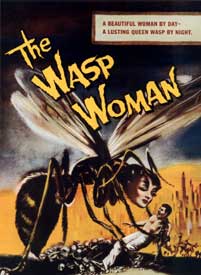
 Meanwhile in the city, Janice Starlin (Susan Cabot in her last film role) is at her board-meeting for Janice Starlin Enterprises, a cosmetics company she has built up for sixteen years. Sales are slipping because Janice herself has always been the company's symbol of youthful beauty, & she's no longer young. Also she wears ugly glasses & scrunches up her face so that we might not notice she's pretty good looking even before she gets the youth formula.
Meanwhile in the city, Janice Starlin (Susan Cabot in her last film role) is at her board-meeting for Janice Starlin Enterprises, a cosmetics company she has built up for sixteen years. Sales are slipping because Janice herself has always been the company's symbol of youthful beauty, & she's no longer young. Also she wears ugly glasses & scrunches up her face so that we might not notice she's pretty good looking even before she gets the youth formula.

